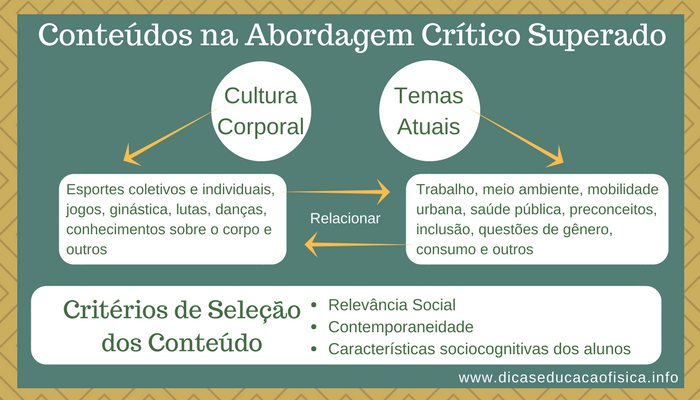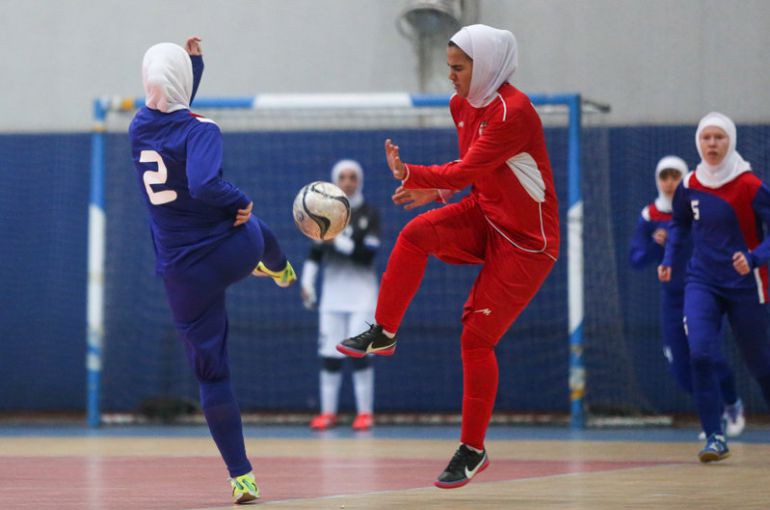Introduction: The Critical Approach
The Critical Approach to Physical Education is a conception of school physical education that opposes the old mechanistic model based on physical performance, the selection of sporting talent, militarism and hygiene.
It is an approach based on the discourse of social justice and Marxist ideas. Educators Dermeval Saviani and José Libaneo are major influencers of this approach.
Concepts of the Critical Approach in Physical Education
- Body Culture: the Critical Overcoming approach understands Physical Education as a discipline that deals with a type of knowledge called Body Culture, whose themes are games, sports, gymnastics, wrestling, dance and others.
- Body Expression: in the Critical Overcoming approach, Body Expression is a language and an object of study of Body Culture.
- Diagnostic approach: the Critical Overcoming approach is diagnostic because it sets out to read the data of reality, interpret it and make a value judgment about it, which depends on the perspective of the judge.
- Judgmental approach: the Critical Overcoming approach is judgmental because it judges the elements of society based on the interests of a particular social class.
- Teleological approach: the Critical Overcoming approach is teleological because it seeks to provide a direction, a solution to the social problems of the social class that reflects it.
Objective of the Critical-Supervisory Approach in Physical Education
The aim of the Critical Overcoming approach in school Physical Education is to allow students to critically assimilate their Body Culture, starting from a rescue of the history of the subject, contextualizing and contesting their reality, relating them to current issues, also contesting common sense, with the ultimate goal of overcoming a reality that is socially unfavorable for that social class.
For example, if in the 1970s school physical education classes in Brazil were aimed at sporting performance, there was obviously an exclusion of the less skilled.
In the Critical Overcoming approach, the theme of Sport in Body Culture would be historically recovered, contextualized, contested, related to current issues (such as inclusion, for example) and a direction would be given to overcome this reality, based on the collective interests of the social class represented.
Methodology of the Critical Approach in Physical Education
The criteria for selecting Body Culture content in the Critical Overcoming approach should be the social relevance of the content (content from Brazilian body culture that has social relevance); the contemporaneity of the content (current themes) and the socio-cognitive characteristics of the students (content that adapts to the student’s level of growth and development).
Once the contents have been chosen, they should be worked on in school physical education classes based on a historical review and contextualization of the facts of reality, providing students with a critical reading of this reality and, from there, the possibility of overcoming and transforming reality.
The teacher must relate the contents of Body Culture, such as sports, games, dances, fights and others, to important current issues in society, such as work and income, the environment, urban mobility, public health, racial and social prejudices, physical disability and inclusion, gender issues, corruption and others, providing a historical, contextualized overview and leading to a critical view of reality, raising issues of power, interests and contestation.
The Critical Overcoming conception in school Physical Education should also have a political-pedagogical role, as it should forward proposals for reflection, intervention and overcoming people’s social reality.
The teacher in the Critical Approach
The teacher within the Critical Overcoming approach in school Physical Education must adopt a posture of dialogue, mediating and problematizing the contents of Body Culture and their relationship with society. The teacher must confront common sense knowledge with scientific knowledge. They must also encourage curiosity, criticality and creativity.
Evaluation: The Critical Approach in Physical Education
Assessment in the Critical Overcoming approach prioritizes the teaching-learning process, completely opposing the model of assessment based on physical and sporting performance, physical tests, athlete selection, etc.
Some of the instruments that can be used to assess students within the Critical Overcoming approach are: non-objective content tests, group work, research work, role-plays, organizing events, self-assessment, among others.
Lesson Plan: Critical Supervisory Approach in Physical Education
This mini lesson plan is for a 9th grade class. It’s always good to remember that the choice of content should also take into account the socio-cognitive characteristics of the student, i.e. their level of growth and development.
Themes
Futsal and inclusion (Body Culture theme and current society themes)
Objectives
Knowing the history of Futsal (Futebol de Salão), knowing the techniques and rules of Futsal and the old Futebol de Salão, recognizing that women should also have the same space as men in this sport, participating in mixed activities without expressing prejudice.
Methodology
Part 1:
- the teacher should gather the students together and give a brief summary of the history of Futsal, its current and former rules
- the class is divided into mixed teams to experience Futsal in practice, with current rules and old rules
Part 2:
- the teacher should bring the class back together to discuss with them how the practice went with old and current rules, what it was like to play with mixed teams, how to solve the problems and conflicts that occurred during the lesson in a democratic way and based on the collective interests of the group
Part 3:
- based on the intervention suggestions made by the students, the activity is restarted with a new format decided by the students
Final part:
- the teacher should bring the students back together for a new collective discussion about the lesson, about the experiences that took place in the lesson, about the collective decisions made by the students, about the experience of resolving conflicts based on democratic and collective decisions, about the inclusion of women in sport and all the prejudice that women suffer and have suffered throughout history.
Final considerations
The Critical Approach in school physical education has always been criticized for its lack of practical support. It is difficult to understand how to relate the themes of Corporal Culture to current issues without leaving the specificity of school Physical Education, which is body movement. However, we at Dicas Educação Física believe that by knowing the concepts of this approach and using creativity, it is possible to create lessons that are rich in learning and knowledge for our students.
More about Physical Education
- Principles of Team Sports Pedagogy
- Developmental Approach in Physical Education
- Physical Education Course Plan with BNCC
- Tips for Physical Education Competitions
- History of Physical Education in Brazil
- Renewed Health in Physical Education
- How to Draw Up a Physical Education Lesson Plan: Step by Step


